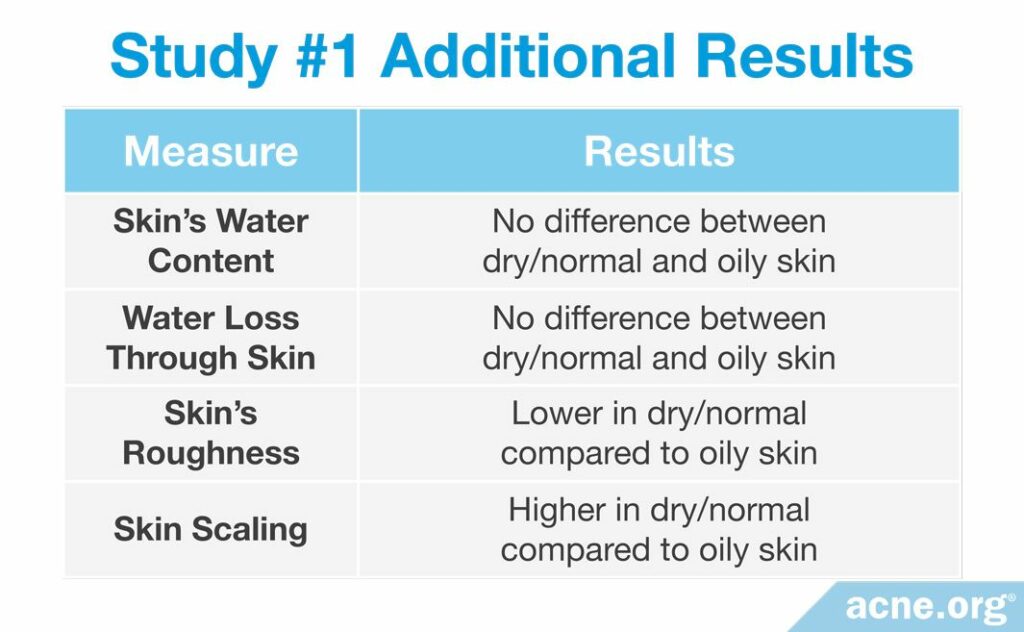Dry Skin Might Age Faster than Oily, Acne-prone Skin, but Research Is Still in the Early Stages

The Essential Info
People with acne tend to have naturally oily skin. However, there may be a silver lining to this. Recent research suggests that dry, acne-free skin may age more quickly than oily, acne-prone skin. This may be because dry skin thins out more quickly and tends to form deeper wrinkles at a faster rate.
However, this is a new area of research, and it’s too early to draw firm conclusions from the three studies we have so far. But it’s exciting nonetheless. Maybe having acne when you are younger means you will retain thicker skin with less wrinkling and fewer signs of aging in the long term. Justice at last!

The Science
- Signs of Skin Aging
- Studies Showing That Dry Skin Might Age Faster than Oily Skin
- How Do I Know My Skin Type?
Although the research on this is preliminary, some findings suggest that dry skin might age faster than oily, acne-prone skin. In other words, there may be a silver lining to having acne-prone skin!
Let’s take a quick look at the signs of skin aging. Then, we can dive into the evidence showing that dry, acne-free skin might be quicker to develop these aging signs.
Signs of Skin Aging
Aging skin develops a few telltale signs:
- Skin thinning
- Wrinkles
- Sunspots (brown spots after sun exposure)
- Uneven skin color
- Skin sagging1,2
Very few studies have looked at how quickly these signs of aging appear in different skin types. Only three studies have come close to tackling this question, and all seem to point to dry skin aging faster than oily, acne-prone skin.
Studies Showing That Dry Skin Might Age Faster than Oily Skin
Study #1: Dry skin might thin out faster than oily skin
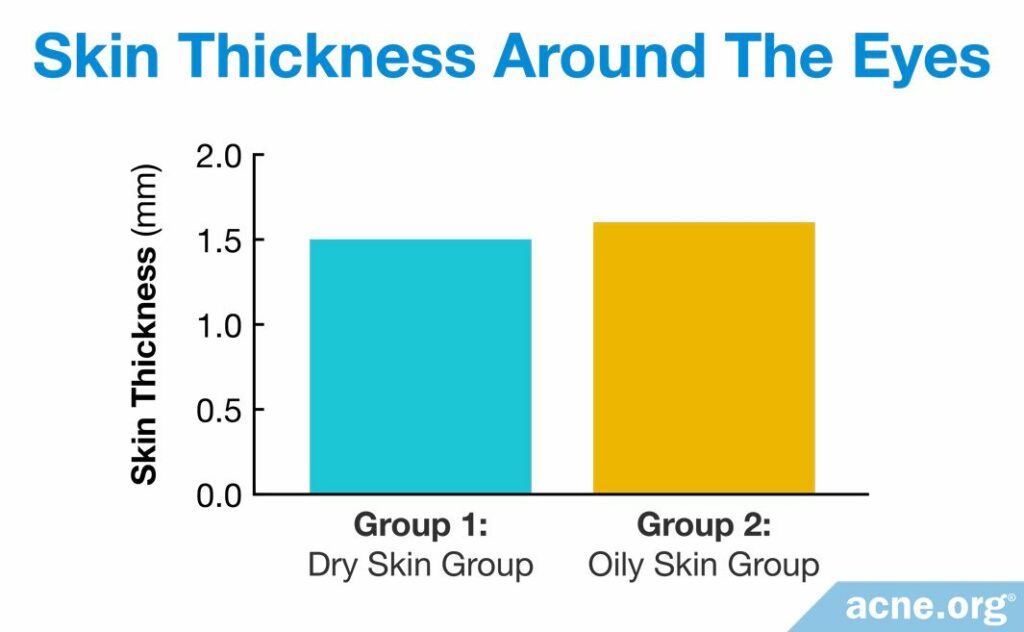
In this study, researchers looked at skin aging in 60 women between the ages of 39 and 55. They divided the women into two groups according to their skin type: Group 1 for dry or normal skin and Group 2 for oily skin. The scientists then took various measurements of the women’s skin and compared them between the two groups.3
The researchers found several differences, but when it comes to aging, the most important difference was that the women in Group 1 had thinner skin compared to the women in Group 2. As we discussed, skin thinning is one of the signs of skin aging. In other words, the women with dry or normal skin had thinner skin, and therefore probably older-looking skin than the women with oily skin.
This is good news for acne-prone people, whose skin tends to be oily. These results suggest that acne-prone skin might thin out more slowly and thus look youthful longer than dry skin.
On the other hand, the researchers found no differences in wrinkles between the two groups. In other words, when it came to wrinkles, people with dry/normal skin and people with oily skin developed these signs of aging at about the same rate.
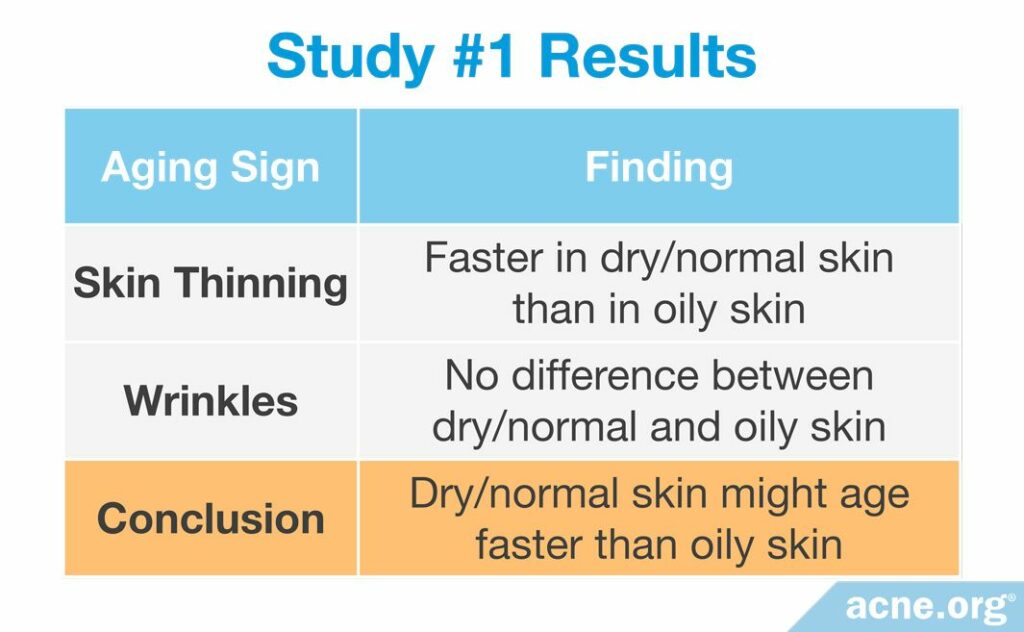
Study #2: Dry skin might develop deeper wrinkles than oily skin
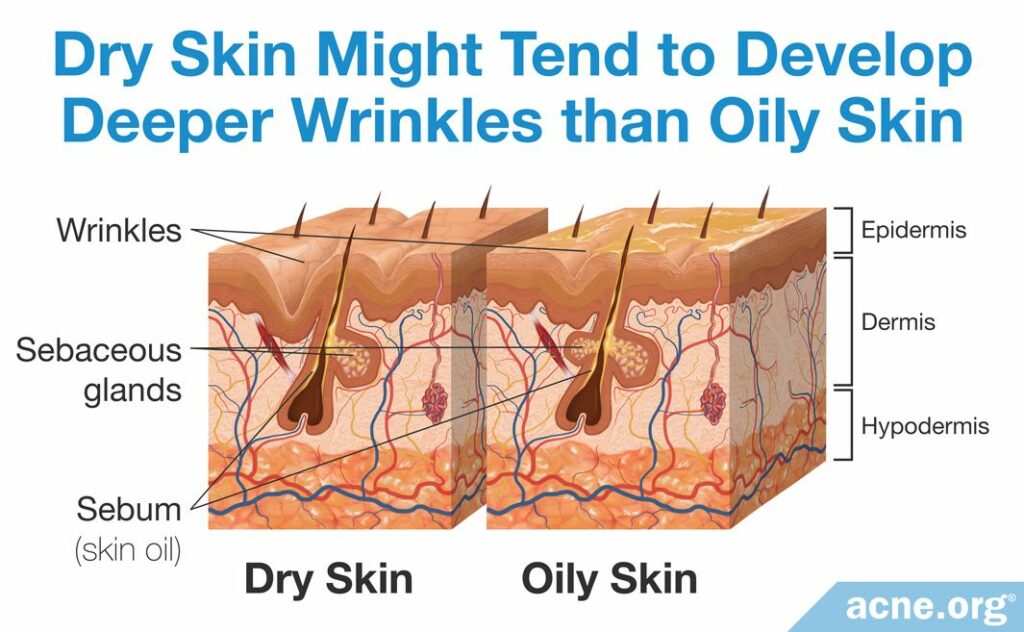
In this study, researchers wanted to see whether having more skin oil glands (the glands that produce skin oil) slows down the development of wrinkles. If so, this would suggest that dry skin should develop wrinkles faster than oily skin.
To answer this question, the scientists looked at samples of skin from men and women who had died at various ages, from their twenties to their nineties. They took these skin samples from two areas on the face: the forehead and near the side of the eye, where so-called “crow’s feet” develop.4
The researchers measured the number of skin oil glands in the samples and also looked at the depth of wrinkles on the skin. They found that people who had more skin oil glands on their foreheads also had shallower wrinkles. In other words, skin oil seemed to protect the skin on the forehead from wrinkling.
On the other hand, in the “crow’s feet” region of the face, which contains few skin oil glands, wrinkles tended to be deeper.
Together, these findings suggest that dry skin, which produces less skin oil, might develop deeper wrinkles more quickly and thus age faster than oily skin.
Keep in mind that right now, this is just a hunch. All that we can safely say from this study is that people with fewer skin oil glands may develop deeper wrinkles. Do people with dry skin actually have fewer skin oil glands than people with oily skin? This would certainly make sense, but we do not know for sure. More research is necessary to show the link between the number of skin oil glands and dry or oily skin.
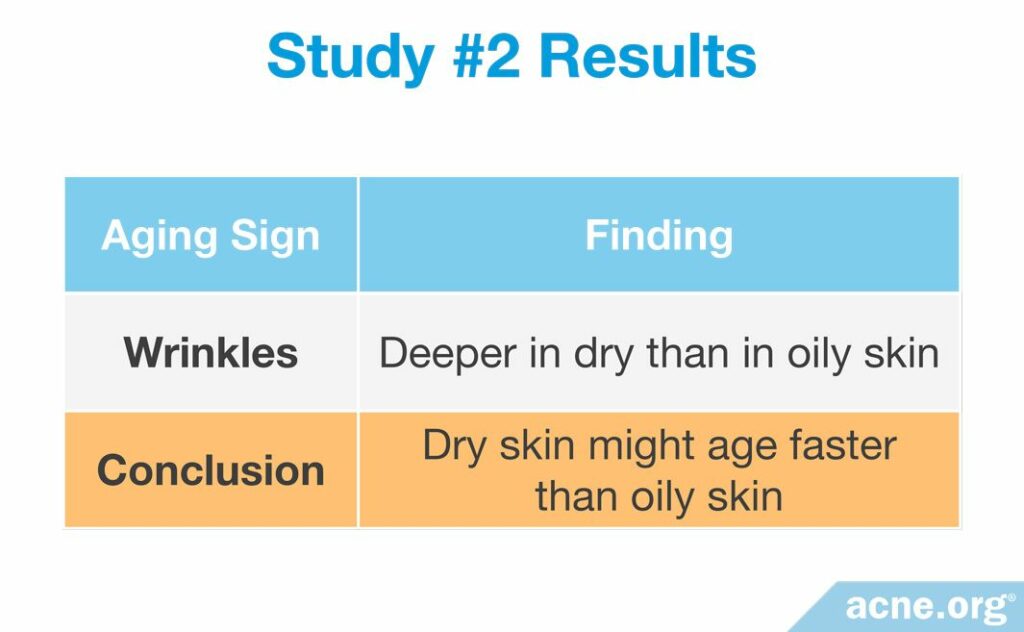
Expand to reveal details of study

This study was published in 2015 in the journal Clinical Anatomy. Interestingly, the researchers also found that skin that contained fewer skin oil glands had two additional characteristics that might go hand-in-hand with faster aging. Skin with fewer skin oil glands tended to:
- Be thinner
- Exhibit more solar elastosis (a loss of skin elasticity caused by sun exposure)4
While it is difficult to draw strong conclusions from this, these findings do suggest that dry skin might be less resistant to aging due to environmental factors like sun exposure.
Study #3: Acne-free skin might age faster than acne-prone skin

In this study, researchers wanted to see whether suffering from acne in youth might speed up or slow down skin aging later in life. Surprisingly, they found that people who never had acne might show signs of skin aging more quickly compared to those who did have acne. In other words, developing acne might slow down skin aging!
First, the researchers asked female twins whether they had ever suffered from acne. Then, they took samples of the females’ blood and skin and performed genetic tests to look for signs of aging at the cellular level. They found that females who had been acne-free possessed two genetic signs that their skin might be aging faster compared to women who had suffered from acne.5
This study is fascinating, but it leaves many unanswered questions. How does having acne protect your skin from aging? Or is it just a coincidence that people who suffered from acne happen to age more slowly?
In addition, the study is not perfect. One limitation is that the researchers only know from the participants’ questionnaire responses whether or not they had acne in youth. In other words, the scientists did not confirm the information by checking the participants’ medical records. This introduces the possibility of mistakes if the participants misremembered their history of acne. A second limitation is that the study only looked at female subjects. In other words, we do not know whether the results also apply to males.
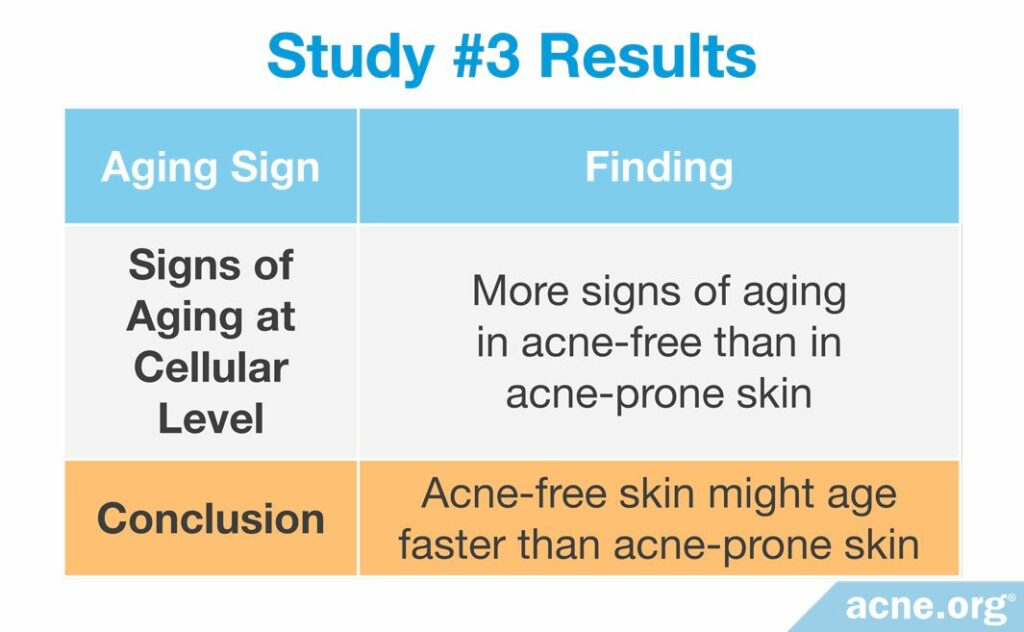
Expand to read details of studies

This study was published in 2017 in the Journal of Investigative Dermatology. The researchers found two signs of faster cellular aging in the skin of females who had never suffered from acne:
1. Their chromosomes (rope-like masses of DNA containing their genes) had shorter telomeres. Telomeres are short caps at the ends of chromosomes, and they play an important role each time a cell divides and copies its DNA. The shorter the telomeres, the fewer times a cell can divide. In other words, this finding suggests that in women who never had acne, skin cells stop dividing earlier than in women who did have acne. The sooner skin cells stop dividing, the sooner a woman’s skin stops rejuvenating itself and looking youthful. Put another way, women who had acne in their youth might keep younger-looking skin for a longer time.
2. Their skin cells activated a specific gene called ZNF420 more often compared to the skin cells of women who had suffered from acne. This gene works to kill skin cells that are no longer needed–a process that tends to happen when the skin ages. In other words, women who had never had acne seemed to have more signs of dying skin cells compared to women who had experienced acne.5
Together, the results of these three studies imply that dry, acne-free skin might age more quickly than oily, acne-prone skin. However, these findings are preliminary, and we need more studies before we can draw any firm conclusions. Still, it is comforting to know there may be a silver lining to having acne-prone skin!
How Do I Know My Skin Type?
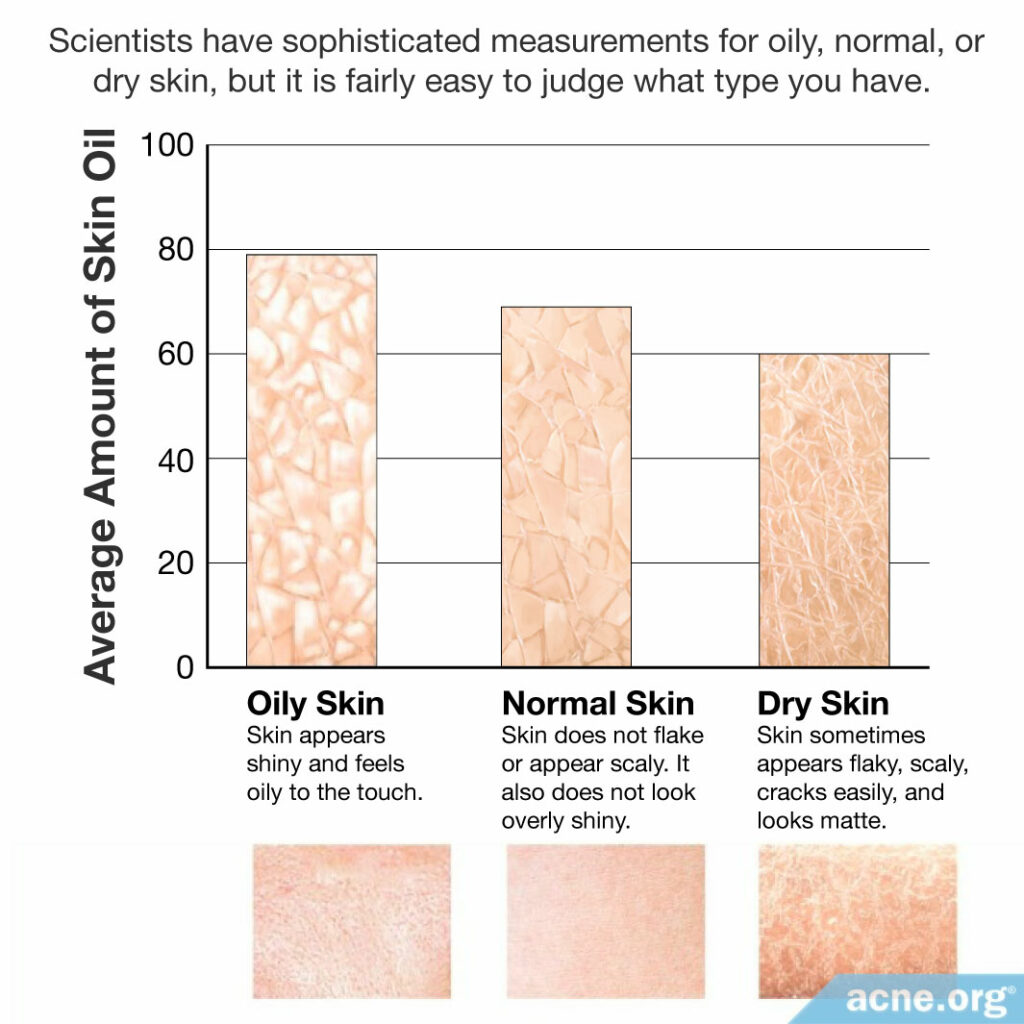
So how do you know which skin type you have? Here are some quick ways to tell dry and oily skin apart.
Compared to oily skin, dry skin tends to:
- Flake off in visible patches
- Look scaly
- Crack easily
- Look matte (not shiny)6,7
As the name suggests, dry skin produces less skin oil compared to oily skin. Using advanced imaging and other techniques, scientists can determine the number of pores and skin oil glands in a person’s skin and measure how much skin oil the skin produces7,8, but in the real world, it’s fairly easy to determine at a glance whether you have dry or oily skin.
However, it is important to note that your skin type may change as you age, particularly in your senior years. This is likely for two reasons:
- The skin may produce less skin oil as we age.
- Throughout your life, you are exposed to the sun’s rays, which may also slowly cause the skin to produce less skin oil over time.9
The full scoop on skin types
The studies we have looked at might suggest that there are only two skin types: dry/normal and oily. In reality, cosmetologists typically classify skin into four basic types:
1. Dry skin
2. Oily skin
3. Combination skin
4. Sensitive skin
Cosmetologists use these skin types to determine the appropriate skin care regimen for each person.
However, many experts believe that even this classification is too simple. For example, the Baumann Skin Type Indicator (BSTI) is a system for classifying skin into 16 different types. The BSTI uses a 64-item questionnaire to determine whether a person’s skin is:
- Dry or oily
- Sensitive or resistant
- Pigmented or nonpigmented
- Wrinkled or unwrinkled (tight)
Since there are two options for each category, there are 16 possible combinations altogether.6
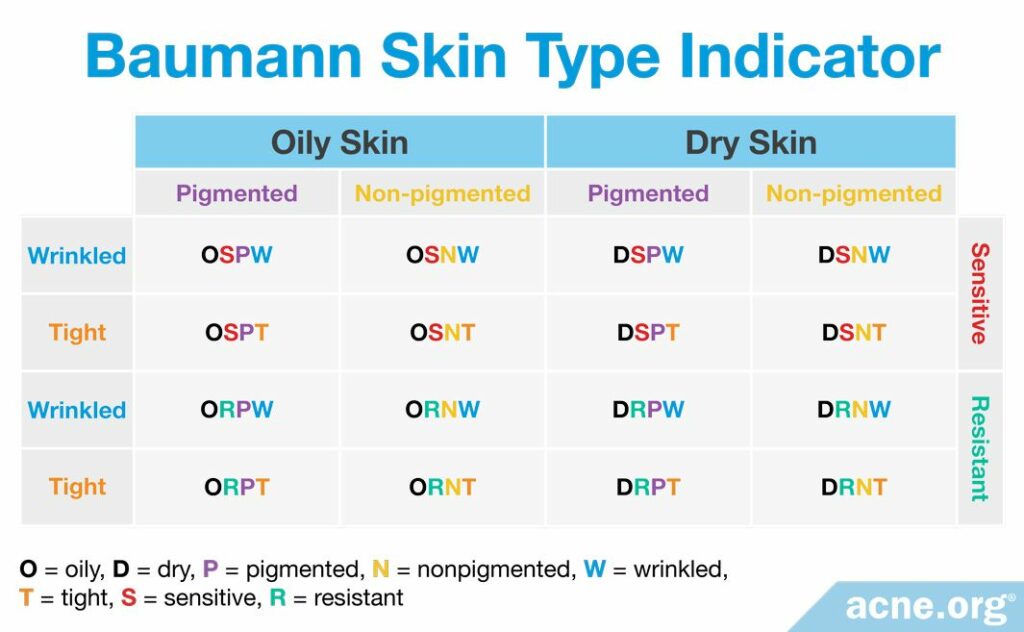
The full scoop on dry versus oily skin
At the tissue level, dry skin is thinner and contains less water. In the absence of water, skin cells that die do not flake off properly. Instead of breaking down correctly, the connections between dead skin cells stay strong, so that the dead skin cells come off in whole sheets. This is what makes dry skin look scaly and flaky. In addition, lack of water may lead dry skin to develop cracks. Cracks are problematic because they can serve as a doorway for pathogens (viruses, bacteria, and fungi).6,7
What Causes Skin Aging?
Our skin type is only one factor that plays into how quickly our skin ages. There are many other factors, some intrinsic (part of our own bodies and biology) and others external (caused by our environment).
Intrinsic factors that determine how fast our skin ages include:
- Production of free radicals (harmful chemicals that naturally form in our bodies during our lives)
- Genetic factors10
- Hormonal factors1,2,11-13
These intrinsic factors are part of our natural aging, which scientists consider largely outside our control. However, as researchers learn more about the genes involved in skin aging, it may one day be possible to develop therapies that target these genes to slow down skin aging.10
External factors that can speed up our skin’s aging include:
- Exposure to the sun’s rays
- Pollution
- Smoking
- Poor diet
- Repetitive muscle movements such as frowning
- Some infections that can speed up skin aging1,2,11,12
To some extent, we can control these factors in order to try to slow down skin aging.
One thing that can result from a combination of internal and external factors is the buildup of dysfunctional skin cells over our lifetime. These “broken” skin cells decrease the skin’s ability to repair itself, contributing to skin aging.14
References
- Vashi, N.A., de Castro Maymone, M. B. & Kundu, R. V. Aging differences in ethnic skin. J Clin Aesthet Dermatol. 2016 Jan;9(1):31-8. https://www.ncbi.nlm.nih.gov/pubmed/26962390
- Zhang, S. & Duan, E. Fighting against skin aging: The way from bench to bedside. Cell Transplant. 2018 May;27(5):729-738. doi: 10.1177/0963689717725755. Epub 2018 Apr 25. https://www.ncbi.nlm.nih.gov/pubmed/29692196
- de Melo, M. O. & Maia Campos, P.M.B.G. Characterization of oily mature skin by biophysical and skin imaging techniques. Skin Res Technol. 2018 Aug;24(3):386-395. doi: 10.1111/srt.12441. Epub 2018 Feb 13. https://www.ncbi.nlm.nih.gov/pubmed/29441614
- Tamatsu, Y., Tsukahara, K., Sugawara, Y. & Shimada, K. New finding that might explain why the skin wrinkles more on various parts of the face. Clin Anat. 2015 Sep;28(6):745-52. doi: 10.1002/ca.22571. Epub 2015 Jul 1. https://www.ncbi.nlm.nih.gov/pubmed/26133537
- Ribero, S., Sanna, M., Visconti, A., Navarini, A., Aviv, A., Glass, D., Spector, T.D., Smith, C., Simpson, M., Barker, J., Mangino, M., Falchi, M. & Bataille, V. Acne and telomere length: A new spectrum between senescence and apoptosis pathways. J Invest Dermatol. 2017 Feb;137(2):513-515. doi: 10.1016/j.jid.2016.09.014. Epub 2016 Sep 28. https://www.ncbi.nlm.nih.gov/pubmed/27693374
- Baumann, L. Understanding and treating various skin types: the Baumann Skin Type Indicator. Dermatol. Clin. 2008 Jul;26(3):359-73, vi. https://www.ncbi.nlm.nih.gov/pubmed/18555952
- Youn, S. W., Kim, S. J., Hwang, I. A. & Park, K. C. Evaluation of facial skin type by sebum secretion: discrepancies between subjective descriptions and sebum secretion. Skin Res Technol. 2002 Aug;8(3):168-72. https://www.ncbi.nlm.nih.gov/pubmed/12236886
- Maia Campos, P. M. B. G., Melo, M. O. & Mercurio, D. G. Use of advanced imaging techniques for the characterization of oily skin. Front Physiol. 2019 Mar; 26(10):254. https://pubmed.ncbi.nlm.nih.gov/30971936/
- Hou, Xiaoxiao et al. Aging in the sebaceous gland. Frontiers in Cell and Developmental Biology 2022 Aug; (10):909694. 17 Aug. https://www.ncbi.nlm.nih.gov/pmc/articles/PMC9428133/
- Zou, Z. et al. (2021) A single-cell transcriptomic atlas of human skin aging. Developmental Cell 56(3). https://doi.org/10.1016/j.devcel.2020.11.002.
- Makrantonaki, E., Bekou, V. & Zouboulis, C. C. Genetics and skin aging. Dermatoendocrinol. 2012 Jul; 4(3) 280 – 284. https://www.ncbi.nlm.nih.gov/pmc/articles/PMC3583889/
- Clatici, V.G., Racoceanu, D., Dalle, C., Voicu, C., Tomas-Aragones, L., Marron, S,E., Wollina, U., & Fica, S. Perceived age and life style. The specific contributions of seven factors involved in health and beauty. Maedica (Buchar). 2017 Sep;12(3):191-201. https://www.ncbi.nlm.nih.gov/pubmed/29218067
- Lephart, E. D. Equol’s anti-aging effects protect against environmental assaults by increasing skin antioxidant defense and ECM proteins while decreasing oxidative stress and inflammation. Cosmetics 2018, 5, 16; doi:10.3390/cosmetics5010016. https://www.mdpi.com/2079-9284/5/1/16
- Ho, C.Y. and Dreesen, O. (2021) Faces of cellular senescence in skin aging, Mechanisms of Ageing and Development, 198:111525. https://doi.org/10.1016/j.mad.2021.111525
The post Which Skin Type Ages Faster? appeared first on Acne.org.


